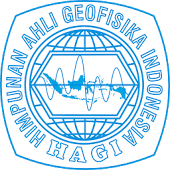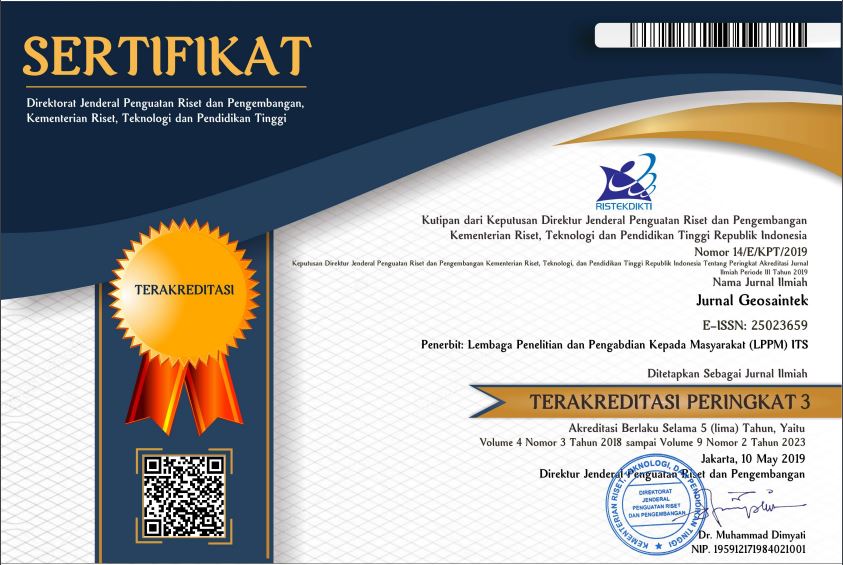Identifikasi Kualitas Site Seismik di Sulawesi Tenggara Berdasarkan Analisis Spektrum Noise Seismik
Abstract
Seismic stations are usually located in bedrock areas and stored in boreholes with the aim of protecting the seismometer from temperature and vibration due to weather changes. In general, the most widely used seismometers are broadband seismometers which have a wide frequency range so they record a lot of noise. PSD and PDF analysis were used to evaluate the noise characteristics of seismic stations. The standardization of high and low seismic noise refers to the Peterson Model. This research was conducted with the aim of knowing the quality of seismic stations in Southeast Sulawesi through analysis of the level of seismic noise sources that affect the quality of seismic data. The evaluation of the seismic site quality is based on the PSD value percentage parameter by calculating the PSD value of the signal recorded on June 17 to June 20, 2022. Various kinds of seismic noise in the resulting spectrum will be seen whether it is still within the limits of the Peterson Model or not. Based on the signal spectrum images obtained, there are 9 seismic sites in Southeast Sulawesi with ideal site quality, which can record seismic signal data and seismic noise sources activity well, namely BBSI, KKSI, PKCI, RKCM, WKCM, UKCM, WWCI, and KDI. Meanwhile, one seismic site with poor site quality cannot record seismic signal data and seismic noise sources activity, namely the LKCI seismic site. The seismic noise level at a frequency of 5-10 Hz originating from human activities and vehicles is the highest indicated by the LKUCM seismic site.
Keywords
seismic site, seismic noise, Peterson Model
Full Text:
PDFReferences
Gunawan, M.T., dan Tim, (2021), “Penilaian dan Pengelolaan Kualitas Data Seismik”, Pelatihan teknis seismic data processing.
Hasselmann, K., (1963), “A Statistical Analysis of the Generation of Microseisms”, Rev. Geophys, Vol.1, hal.177-210.
Longuet_Higgins, M.S., (1950), “A Theory of the Origin of Microseisms”, Phil Trans. R.Soc. Lond, Vol.A, No.243, hal.1-35.
McNamara, D.E., and Buland, R.P., (2004), “Ambient Noise Levels in the Continental United States”, Bulletin of Seismological Society of America, Vol.94, No.4, hal.1517-1527.
McNamara D.E., Boaz, R.I., (2005), “Seismic Noise Analysis System Using Power Spectral Density Probability Density Functions : A Stand Alone Software Package”, Open-File Report 2005-1438, USGS, Colorado, USA.
McNamara, D.E., Buland, R.P., Boaz, R.I., Weertman, B., Ahern.T., (2005), “Ambient Seismic Noise”, USGS, Colorado, USA.
McNamara, D.E., (2005), “Ambient Noise Probability Density Function”, USGS, Colorado, USA.
McNamara, D.E., C.R., Gee, L.S., Benz, H.M., and Buland, R.P., (2009), “A Method To Establish Seismic Noise Baselines for Automated Station Assessment”, Seismological Research Letters, Vol. 80, No.4, hal.628-637.
Peterson, Jon., (1993), “Observations and Modeling of Seismic Beckground Noise”, Open-File Report hal.93-322, USGS, Albuquerque, New Mexico, USA.
Setiyaji, Andri., Agus, M., (2009), “Analisis Kualitas Data Seismik 6 Stasiun Indonesia Menggunakan PQLX”, Skripsi Fakultas Sains dan Teknologi UIN Syarif Hidayatullah.
Yusuf, Mahmud,, Yohanes, T., Ricko, K., (2016), “Evaluasi Kualitas Stasiun Seismograph Berdasarkan Analisis Spektrum Pada Jaringan Seismograph Inatews”, Research gate.
DOI: http://dx.doi.org/10.12962%2Fj25023659.v9i1.13964
Refbacks
- There are currently no refbacks.

Jurnal Geosaintek diterbitkan oleh ITS bekerja sama dengan Himpunan Ahli Geofisika Indonesia (HAGI)
Disebarluaskan di bawah Lisensi Creative Commons Atribusi-BerbagiSerupa 4.0 Internasional.
Berdasarkan ciptaan pada https://iptek.its.ac.id/index.php/geosaintek/index.





